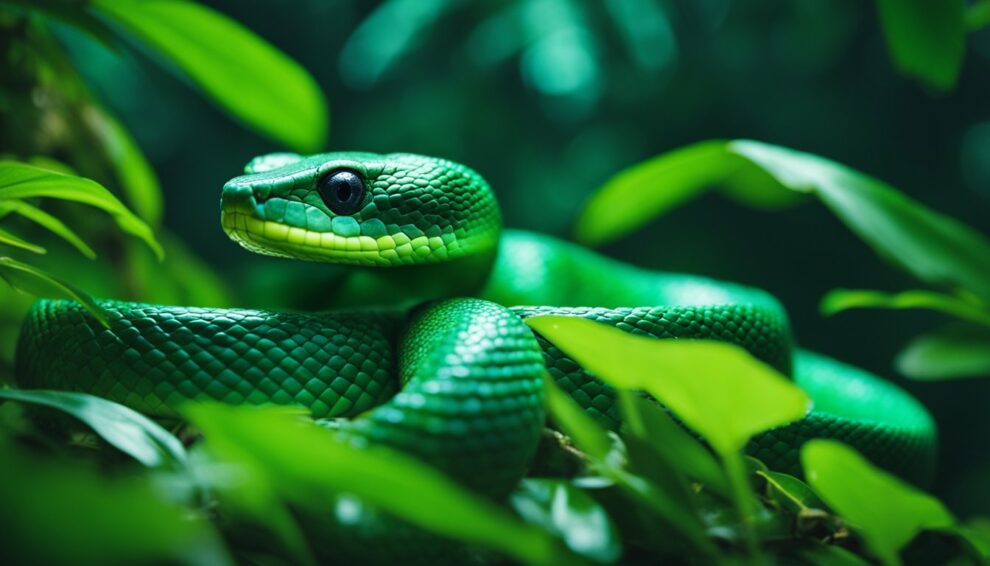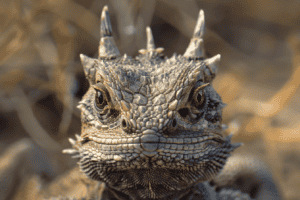Emerald tree boas are masters of the dark, using their incredible night vision to hunt in the dense forests of South America.
When the sun dips below the horizon and the forest plunges into darkness, these snakes become active predators.
They have special heat-sensing pits located between their eyes and nostrils that help them detect the body heat of their prey.
This allows them to accurately strike at the unsuspecting animals that come too close.

Imagine being in the rainforest at night; you hear the rustle of leaves but can’t see anything.
The emerald tree boa, however, sees a world lit up with the warmth of living creatures.
Their eyes are well-adapted for low light conditions, giving them a remarkable edge during the dark hours.
Researchers have discovered that the retina of an emerald tree boa has a high number of rod cells, which are more sensitive to light than the cone cells responsible for color vision.
This means while their color vision might not be the best, their ability to see in dim light is exceptional.
While many animals are bedding down for the night, the emerald tree boa is only just beginning its day.
The snake’s hunting technique is both patient and precise; it coils on a branch and waits for a small mammal or bird to pass by.
With pinpoint accuracy, it strikes, using its sharp teeth to grab the prey. It then wraps its body around its catch, suffocating it before swallowing it whole.
This hunting strategy is not only efficient but also energy-saving, vital for survival in the competitive rainforest ecosystem.
Have you ever wondered what it would be like to see the world through a boa’s eyes?
Their night-time adventures are a perfect example of nature’s adaptability and the intricacies of predator-prey relationships in the wild.
The Eyes of the Emerald Tree Boa

In the shadowy world of the rainforest canopy, the emerald tree boa uses its remarkable eyesight to become an adept nocturnal predator. Curious how?
Let’s find out what’s special about their eyes.
Unique Vision Adaptations
The eyes of the emerald tree boa are highly specialized for night use.
They have large pupils that open wide in the dark to allow in as much light as possible. Inside these eyes, there are layers of cells called photoreceptors.
These cells are incredibly sensitive to light and are divided into two types: rods and cones.
While cones are useful during the day, it is the abundance of rods in a boa’s eyes that gives it a leg up in the dark.
These rods contain a pigment called rhodopsin which is extremely sensitive to light.
Another cool feature? A reflective layer behind the retina, known as the tapetum lucidum.
This handy layer reflects light back through the retina, giving the photoreceptors a second chance to absorb light.
This is what gives many nocturnal animals, including the emerald tree boa, eyeshine when light is shone into their eyes in the dark.
Have you ever seen a cat’s eyes glowing at night? That’s the tapetum lucidum at work!
Nocturnal Hunting Strategies
When the sun sets and the rainforest quiets down, the emerald tree boa’s night begins.
With eyes designed for darkness, this snake expertly navigates the night. It uses its keen vision to spot the warm-blooded prey that shares its treetop realm.
Small mammals and birds that think the cover of darkness can protect them are in for a surprise.
Emerald tree boas are also equipped with heat-sensing pits located between their eyes and nostrils.
These organs detect the infrared radiation emitted by their prey.
When combined with their vision, this ability allows the boa to precisely strike, even in complete darkness.
So, the next time you’re out at night with a flashlight, imagine how the emerald tree boa sees the world, with its super-sensitive eyes picking up the slightest movements and the tiniest warmth signatures from up high in the trees.
Isn’t that something to wonder about?
Prey Detection in the Dark

When the sun sets and darkness blankets the rainforest, emerald tree boas activate their remarkable nocturnal hunting skills to locate their prey.
They have specialized adaptations that allow them to become exceptional hunters in the pitch black of night.
Heat-Sensing Abilities
Emerald tree boas are equipped with a superpower fit for a nocturnal predator: heat-sensing pits.
Located between their eye and nostril on each side of their face, these pits can detect the slightest differences in temperature.
This biological marvel is due to a membrane inside the pits that is sensitive to infrared radiation, essentially enabling the boa to “see” the heat radiated by potential prey.
Even in complete darkness, an emerald tree boa can form a thermal image of the warm-blooded animals nearby.
This ability allows them to strike with precision, honing in on the body heat of unsuspecting creatures, such as small mammals or birds, nestled in the foliage.
Movement and Vibrations
Aside from their thermal vision, emerald tree boas are attuned to the subtleties of movement and vibrations in their environment.
They may hang coiled over forest paths, sensing the vibrations through the branches caused by prey moving through the underbrush.
The slightest rustle or flutter can betray a creature’s location to the sharp senses of the boa.
This combination of sensing heat, movement, and vibration gives the emerald tree boa a formidable toolkit for hunting in darkness.
By focusing on these incredible adaptations, we peek into the nightly life of the emerald tree boa, marveling at how nature has crafted such efficient methods for survival in the dark.
Emerald Tree Boa’s Diet

Understanding the diet of the emerald tree boa is crucial for appreciating how this snake thrives in its habitat.
The prey it consumes not only fuels its nocturnal hunts but also plays a pivotal role in the ecosystem of the rainforest.
Typical Prey
The emerald tree boa, with its sharp-eyed nocturnal vision, mainly hunts warm-blooded animals.
It preys on a variety of small mammals and birds that are active at night.
Utilizing heat-sensing pits located between their eyes and nostrils, they can detect the body heat of these animals, making them efficient hunters in the darkness.
Common prey includes rodents like marsupials and small opossums, which climb trees where the boas lie in wait.
They have also been known to snatch birds resting in the foliage.
Feeding Frequency
Unlike many mammals that need to eat daily, the emerald tree boa eats less frequently.
These snakes may only feed every few weeks, depending on the size of the meal they manage to capture.
After a large meal, their metabolism can slow down, allowing them to digest food slowly and efficiently.
The size and activity level of the prey can influence how often these boas need to hunt.
Though their feeding may be infrequent, each meal is critical for sustaining them over long periods.
Have you ever imagined being full for weeks after just one big meal? That’s the life of an emerald tree boa!
Frequently Asked Questions

Emerald tree boas are skilled nocturnal hunters. They possess distinct adaptations that give them an edge during the dark hours.
Their night hunting techniques intrigue scientists and animal enthusiasts alike.
Let’s explore some common questions about how these snakes operate after the sun sets.
How do emerald tree boas adapt their hunting strategy at night?
Emerald tree boas utilize their exceptional vision and heat-sensing abilities to locate prey in the darkness.
They remain motionless, hanging from tree branches, effectively blending into the foliage.
Their patience pays off when prey comes within striking distance, captured swiftly and stealthily.
What adaptations do emerald tree boas have for nocturnal hunting?
The boa’s heat-sensing pits aligning their lips are remarkable; they can detect minute variations in temperature, assisting in discerning warm-blooded prey even in total darkness.
Their large eyes accommodate more light, enhancing their ability to see in low-light conditions.
Can emerald tree boas see well in the dark, and how does this benefit their hunting?
Indeed, they can see quite well at night. Their eyes have a higher proportion of rod cells, which are very sensitive to light.
This heightened vision allows them to detect the subtle movements of rodents and other prey, facilitating successful hunts under the veil of night.
What role does an emerald tree boa’s diet play in their night hunting habits?
Emerald tree boas mainly prey on small mammals and occasionally birds.
Their diet demands a hunting style that can adapt to the nocturnal activities of these animals.
By hunting at night, they tap into the time when their prey is most active.
How do the teeth of an emerald tree boa facilitate night hunting?
The teeth of an emerald tree boa are long and needle-like, ideal for gripping onto slippery prey.
This dental arrangement is especially useful at night when swift and secure capture is critical, preventing any chance of prey escape.
In what ways do emerald tree boas protect themselves from predators while hunting at night?
While on the hunt, they are also vulnerable to predators.
Their green scales provide camouflage among the leaves, and their slow, deliberate movements prevent detection from both prey and potential threats.
This strategy ensures both a successful hunt and safety throughout the night.









